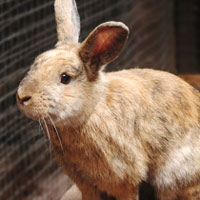Call of the Wild
Senate Bill 1480 Could Save Wildlife
As suburban sprawl continues to displace wild animals, encounters with humans are inevitable. In Santa Barbara, many of our long-burning fires have forced wild animals to relocate, causing an increase in the clashes between humans and animals. Many California residents resort to calling wildlife removal companies for humane removal of unwanted wildlife who take up residence in (or near) their homes. However, pest control companies aren’t required to tell customers whether there are nursing babies who will be left behind (most likely to starve to death) when lactating females are trapped. In addition, once wildlife is removed, the trapper could kill the animal by drowning, crushing, or injection with chemicals. Senate Bill (SB) 1480 is working to change these cruel practices by prohibiting wildlife trappers from removing mother animals when signs of young are present and by requiring that only substances designed specifically for euthanasia be used when euthanizing animals. SB 1480 would also restrict the use of certain lethal traps that are inhumane and can pose threats to companion animals.

SB 1480 is awaiting a concurrence vote in the Senate and then will be sent to the governor. If you want to help wildlife, make polite calls and send emails and faxes to Governor Jerry Brown and let him know that you support SB 1480.
The Honorable Jerry Brown, Governor of California
c/o State Capitol, Ste. 1173
Sacramento, CA 95814
(916) 445-2841; (916) 558-3160 (fax)
http://govnews.ca.gov/gov39mail/mail.php (email form)
Before you call a wildlife removal company, volunteers from the Santa Barbara Wildlife Care Network stress that people need to be compassionate and tolerant of our wild neighbors. Julia Parker, SBWCN director of animal affairs, stated that it is perfectly normal to see opossums, skunks, and raccoons in our backyards, and people shouldn’t automatically want them removed. Parker said that people think the solution is to live trap these animals and move them elsewhere, but this is not an answer. She believes that if you remove wild animals from your yard, you are basically putting up a “for rent” sign showing that no one is living there, and other animals will eventually move in. She encourages people to be patient. Most wild animals are nomadic, and in time they will move on.
Here are some tips to living in harmony with wildlife:
Food
• The smell of garbage is a huge attraction to wildlife. To prevent wild animals from being attracted to your yard, keep lids secured, or store garbage in the garage, especially overnight. For animal-resistant trash containers, visit www.crittercan.org
• Don’t leave pet food or water bowls outside. Always make sure to bring your pets in at night.
• Clean below bird feeders, as seed can attract scavengers such as raccoons and skunks.
• Pick up fruit as soon as it has fallen from the trees.
Lawns and Gardens
• Always check over your lawn before you mow, and search for turtles and rabbit nests. The Humane Society of the United States advises people to move turtles gently, but rabbit nests should be left alone (and don’t mow near them) so that the mother will return to the nest to feed them
• Keep your lawn grub-free, and you will prevent raccoons, skunks, and opossums from tearing up your lawn to feast on them.
• The best way to keep animals out of your garden is to erect a chicken wire fence at least 36 inches above the ground and 12 inches below the ground. You can also place mesh cages over young plants. Motion-activated noisemakers available from garden centers, owl decoys, and pinwheels can also be effective deterrents.
Check Access Points
• Check your deck, and block or screen off any entry points that allow wildlife access.
• Check your roof eaves, overhangs, vents, and even cracks around windows or pipes that lead into the house for bat entryways. They can squeeze through openings 1/2-inch wide. Do not patch holes between May and September, or you may trap young bats inside. For bat-related issues, visit www.batconservation.org
• Once you verify that your chimney is empty, make sure it is capped.
• Remove brush piles from your property, and clear debris close to buildings to reveal burrows as well as openings that small animals might use to get inside.
• Small animals can access buildings through holes as little as one-inch wide, so be sure to seal any holes with heavy-weight material (hardware cloth or heavy-gauge screening) or steel wool. Wire mesh can also be used to plug openings in walls and floors.
Local Resources
Santa Barbara Wildlife Care Network is a nonprofit, volunteer group that rescues and rehabilitates injured wild birds and small mammals in Santa Barbara County. For more information, call (805) 966-9005 or visit www.sbwcn.org
Adoptable Pet of the Week

Micah is inquisitive and playful. He loves to explore and binky, or jump, (something that rabbits do when they’re happy). He is longing for a forever home where he can entertain his humans with his antics and comical semi-floppy ears. Will you be the one to welcome this furry comedian into your heart and home?
Mark your calendars! The Bunny Festival is Sunday, September 23, 12-4 p.m. It is a fundraiser for BUNS. Visit adoptable rabbits, talk to the vet, have the animal communicator talk to your bunny, watch bunny and guinea pig games, rest in the lagomorph lounge, shop at the silent auction, play in the children’s area, shop at vendor booths. For more information, visit http://www.bunssb.org/events.html
Bunnies Urgently Needing Shelter (BUNS) is a volunteer organization that cares for abandoned rabbits. BUNS is located at the Santa Barbara County Animal Shelter, 5473 Overpass Road, Santa Barbara. BUNS works to find bunnies permanent homes and educates the public on caring for a companion rabbit. You can call the County Shelter at (805) 681-5285 or call BUNS at (805) 683-0521 and leave a message for someone to call you back. For more information, visit: www.bunssb.org



